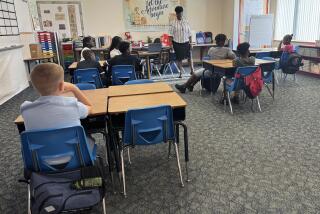When is a school too small?
DOES IT MATTER how big a high school is? Huge, impersonal high schools are universally considered problematic, but can a high school be too small?
That more intimate high schools are superior is the assumption underlying two school reform concepts: charter schools and “small learning communities.” The highly touted Green Dot company, for instance, has opened 10 new charter high schools, each limited to 525 students. SLCs divide giant campuses into sub-schools of about 300 students.
All agree that behemoth schools of 5,000 students on multi-track calendars — such as the Los Angeles School District’s Belmont and Garfield schools, where I taught for a combined 25 years — are far too big. Now, after six years at the LAUSD’s Francisco Bravo Medical Magnet High School, which has 1,750 students, I think a midsized high school is a better model for reform.
The small learning community idea is to divide up large high schools into 300-student clusters, each with an academic focus and its own group of teachers. Students then spend all four years in this mini-school within the larger campus. SLCs aren’t just a solution for huge and crowded schools but part of the LAUSD’s overarching reform plan. Of the 60-plus high schools in the district, 19 already have SLCs and 16 have plans underway. New campuses are being built to accommodate this 300-student model. That’s small. Too small?
For teachers, it sure can be. One teacher I know at an SLC campus at Garfield High has to prepare for four classes every day — world history, U.S. history, government and advanced placement government. SLC teachers also have to meet with two faculty groups — those in their SLC and the other math or science teachers from the whole school. Departmentwide planning suffers.
For students, SLCs or small charter schools mean being trapped with a small pool of teachers for four years — which isn’t necessarily good. At some schools here and in other cities, kids and parents have complained about fewer classes to choose from and scheduling problems, especially for those with multi-track schedules.
Bravo, being neither too small nor too large, has avoided many of those problems, which makes success easier. Bravo’s teachers typically teach two or three subjects each day and can specialize more. My nine-person social studies department easily breaks into subcommittees to hone lessons for world history or a government/economics class. Our entire faculty is about 75 teachers, very manageable compared to 250 or more teachers at some of the huge, multi-track schools. We’re all on the same calendar too, making it easier to work together.
Bravo is small enough that few students fall through the cracks. Counselors — even the clerks in the attendance office — know students by name. Yet we also are able to offer a dizzying array of electives: jazz band and modern dance, Latin American studies and art history, nursing and computer digital imaging. We have honors or advanced placement classes in languages, history, literature and science.
Is our just-right size paying off?
Last year, not one of our seniors failed to graduate because he or she hadn’t passed the state’s mandatory exit exam. Our Academic Performance Index score — a number between 200 to 1,000, based mainly on state tests — is 818, the fourth highest in the LAUSD. Beverly Hills High School, by comparison, scored an 820.
Bravo is a magnet school, but there is no entrance requirement. Almost 90% of the students come from immigrant families, and 85% qualify for the federal free/reduced lunch program. And yet Bravo earns awards for excellence and improvement from the state and federal governments. More important, our dropout rate is 5%, and 95% of our graduating seniors go to college.
As parents and citizens, we can only ask for the kinds of schools we want if we know what doesn’t work — and also what does. Multi-track school calendars, for instance, faced years of negative publicity and even a class-action lawsuit before the LAUSD pledged to return all its schools to a traditional school calendar by 2012. Similarly, we all need to push for high schools of the right size.
No high school should have more than 2,500 students. New charter high schools might be better off growing to 1,700 students rather than sticking to 525. And we must rethink the small learning community model. Why rob high schools of one of their best potential assets: a large-enough faculty to diversify the curriculum without burning out teachers?
High schools can in fact have the academic richness of the best small colleges, with faculty members who specialize in subjects they love. That’s exactly what it feels like teaching at Bravo. The students reap the benefits. Size does matter after all.
More to Read
Sign up for Essential California
The most important California stories and recommendations in your inbox every morning.
You may occasionally receive promotional content from the Los Angeles Times.










